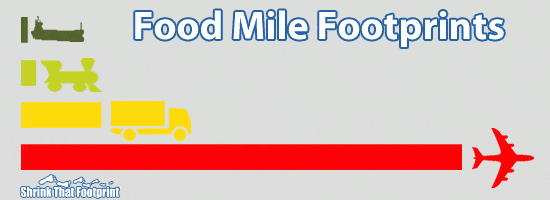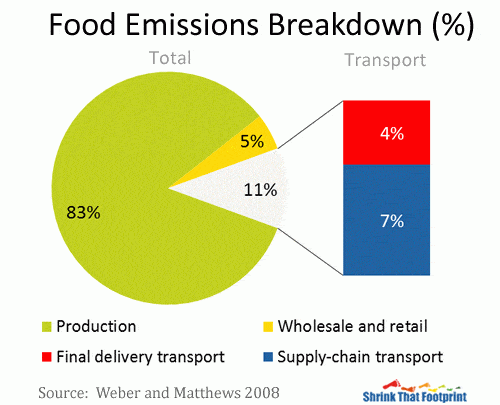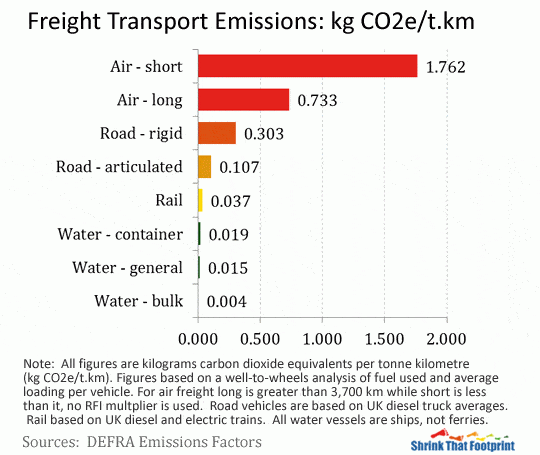
Definition Of Food Miles – What Are Food Miles?
Food miles is defined as the distance food travels before being consumed where greater distance implies greater carbon emissions associated with the food. As food consumption is one of the big three components of carbon emissions, considering food miles is important to understand whether its one of the factors that is worth spending effort on to reduce. For food that is grown or harvested far away, from another state or country, this can be thousands of miles. For food that is local from a nearby far, this is a handful of miles. Food miles are important because the greater the distance, the more carbon is emitted due to transport. Therefore, when you eat food from far away, you’re contributing loads of hidden carbon emissions. Food miles belongs to the more general topic of food sustainability.
However, here we mention that the topic of food miles itself needs a health warning. Tackling them will support local food, but won’t always cut carbon emissions.
Example Of Food Mile And Carbon Emission Calculation
Suppose you have a steak for dinner. That steak was transported from a farm by truck from the Midwest US to where you are, let’s say that’s 1,000 miles away. That steak didn’t come by itself. Then referencing the table below, we know that truck transport emits 18 g CO2 per ton of food and per kilometer. Then that shipment bringing your steak would have cost 18 g CO2 per ton per kilometer x 225 g x 1,000 kilometers. The total shipment mileage was 1,000 kilometers, which results in carbon emissions of 4.5 g CO2.
Is this a lot? Well, consider the carbon emissions of a steak from our numbers on meat-related emissions. An equivalent steak as above would lead to 25 kg CO2 emissions. The transport-related carbon is 4.5 g CO2 which means it’s ~15% of the total carbon emissions.
If the steak traveled by a truck, the carbon emissions would be ten times higher! And steak delivered by air would yet again be 3-4 times higher.
Food Miles in perspective – Do Food Miles Matter?
The concept of food miles, the distance food travels before being consumed, dates back to a 1994 report called “The Food Miles Report: The dangers of long-distance food transport”.
At first glance reducing food miles seems an excellent way to reduce carbon emissions, because it limits emissions caused by planes, trucks, boats and trains moving food. But if you’re not careful, cutting food miles paradoxically will increase your food’s carbon footprint.
Food Miles Facts
Here we present the breakdown of food-related carbon emissions in table form derived from a Weber and Matthews 2008 study titled “Food-Miles and the Relative Climate Impacts of Food Choices in the United States”, two authors at that time based at Carnegie Mellon. The greatest contribution as we mentioned is production of the food. The remaining 17% are related to delivery and sales which will include storage, presentation at the point-of-sale.
| Food Emissions Contribution | Percentage |
| Production | 83% |
| Supply chain transport | 7% |
| Final-leg delivery transport | 4% |
| Wholesale and retail | 5% |
| Other | 1% |
| Total | 100% |

Food Transport Estimates Consider 10 Types Of Transportation Modes
Weber and Matthews based their estimates using a set of conversion factors for carbon emissions and type of transport. Note that air travel per kilometer basis is 30 times more expensive than by rail freight. Water travel (inland water), most likely meaning transport along a river, is very similar to rail in terms of energy costs. In fact, water travel is proposed as a powerful technology that enabled early civilizations to grow and maintain large populations because it only required development of water vehicles.
| Transportation Mode | MJ/t-km | g CO2e/t-km |
| inland water | 0.3 | 21 |
| rail | 0.3 | 18 |
| truck | 2.7 | 180 |
| air | 10.0 | 680 |
| oil pipeline | 0.2 | 16 |
| gas pipeline | 1.7 | 180 |
| international air (a) | 10.0 | 680 |
| international water container | 0.2 | 14 |
| international water bulk | 0.2 | 11 |
| international water tanker | 0.1 | 7 |
Food Transport Makes Up 11% Of Food Emissions, The Rest Is Production
The most important thing to remember about food miles is that they are only part of the bigger food emissions story. A person’s foodprint is dominated by production emissions. Food transport makes up a little under a tenth of food emissions up to the point of sale.
A Careful Analysis Shows 83% Of Food Carbon Costs Is Due To Production
A few different studies have verified this, perhaps the best of which is the 2008 paper by Weber and Matthews, Food-Miles and the Relative Climate Impacts of Food Choices in the United States. Their analysis of US food emissions found 83% of carbon emissions in the food system result from food production. The remainder is 5% from wholesaling and retailing food, and 11% from transporting it.
Perhaps most interestingly, just 4% of total emissions were for final delivery transport from the producer to the retailer. The cost of delivery is what most people think of when they talk about food miles.
Making Choices Based on Food Miles In Isolation Can Raise Carbon
The point is food miles are only a small part of a very large food emissions story. Focusing on them in isolation isn’t necessarily helpful if your goal is to cut your foodprint. In fact what you eat is generally more important than where it comes from, as is how much you waste. You might pick a food that has less food miles than another. However, that food in fact could have higher production carbon costs because its inefficiently grown. Then your choice has led to greater carbon emissions even though the “food miles” have gone down.
Consider Changing What And When You Eat To Address Production Emissions
The problem of focusing purely on food miles to reduce emissions is easy enough to understand. The classic example is the much-loved tomato.
In cooler climates like northern Europe, Canada and the northern US, people eat tomatoes all year round. This is despite the local weather not being conducive to growing them. Winter tomatoes in these places are either hot-housed locally, using significant amounts of energy, or imported from warmer climates like Spain or Mexico.
Imported Food Can Have Lower Carbon Foodprints Than Locally Grown
When you analyse the respective carbon footprints of local and imported tomatoes it becomes clear that production emissions can easily dwarf transport emissions. A good example comes from a 1998 paper by Annika Carlsson. Carlsson showed that tomatoes imported from Spain to Sweden have much lower footprints that those locally grown.

Despite travelling a greater distance Spanish tomatoes imported to Sweden have a far smaller footprint than locally grown ones. This is because the emissions generated to heat and light greenhouses in northern Europe are very carbon intensive. The level of carbon emissions exceeds that of importing tomatoes from Spain.
Local Grown Under Specific Circumstances Can Beat Imports
Researchers have found similar results when comparing out of season English tomatoes to Spanish imports. There are also some noble exceptions to this rule. For example both in Sweden and England it is possible to get low carbon winter tomatoes. These tomatoes are raised with waste heat, renewable energy and highly efficient hydroponic systems.
So does this mean targeting food miles is a complete waste of time? Notcompletely. But if your motivation for eating more local food is carbon emissions, then it is better to try to eat seasonal local food.
Change Your Diet According to Season Is A Simple Way To Balance Carbon Emissions
You ensure both production emissions and transport emissions are limited by eating food that is in season and local you can be more certain that . You can avoid refrigeration in stores too as cooling is a source of carbon emissions. Even more importantly, seasonal food just tastes so much better.
Where I live in the UK eating a tomato or strawberry from Spain doesn’t taste anything like as sweet as one in season from a local farm. For more info see our article on the rationale for sustainable farming that touches on these issues of transportation and quality production. Not only are imported varieties a bit bland to begin with, but they suffer from time in storage, in refrigeration and in forced ripening.
Of course not even locally grown tomatoes can compare to eating one of your own. 😉
Food Transported By Air Is 5 To 50 Times More Carbon Intensive
If you are going to try and tackle food miles, the natural place to start is with flying food, but even then its not always simple.
From an emissions perspective food miles are not equal. In the UK producers and retailers transport just 1% of food, but it accounts for 11% of emissions.
Using figures from DEFRA (which differly slightly from Weber and Matthews) we can compare the emissions that result moving a tonne of food by different means.

The figures are pretty stark. Food that flies can generate more than one hundred times the carbon emissions per kilometre of food that travels by ship.
If I eat a banana that has been shipped to the UK from Colombia its transport emissions are relatively small. But if I eat an avocado flown in from Mexico they are huge.
Certain Foods Are Only Available Via Air Transport
Depending on where you live the food that flies will be very different. European countries get a lot of beans, sweetcorn, asparagus, podded peas, limes, avocados, spring onions, pineapple, grapes and sweet potato from Africa and Central America. Sellers also fly in a lot of fish from Asia and South America. There is no great alternative because producers can’t grow these fishes locally and as cheaply. Moreover fish tends to have relatively high value for its weight.
Don’t Cut Off Imported Food So Quickly
Limiting the amount of flying food is a way reduce food transport emissions. Refine this choice by thinking about those decisions in the proper context. Both in terms of total emissions and economic impact. If you know the food you are eating is shipped in from a far, the chances are those food miles create relatively few carbon emissions. At the same time buying these foods adds valuable income to producers in low income parts of the world.
However even when food has been flown in, it can still sometimes be less carbon intensive than things grown locally. This is because the carbon intensity of production in Africa is many fold lower than that in Europe. This offsets the emissions from the food miles. In the future as developing countries increase energy use and consumption, carbon intensity calculus will change again.
Viewing food miles in isolation can be terribly misleading. You need to focus on the whole supply chain.
That is the tricky truth of food miles.
Lindsay Wilson
I founded Shrink That Footprint in November 2012, after a long period of research. For many years I have calculated, studied and worked with carbon footprints, and Shrink That Footprint is that interest come to life.
I have an Economics degree from UCL, have previously worked as an energy efficiency analyst at BNEF and continue to work as a strategy consultant at Maneas. I have consulted to numerous clients in energy and finance, as well as the World Economic Forum.
When I’m not crunching carbon footprints you’ll often find me helping my two year old son tend to the tomatoes, salad and peppers growing in our upcycled greenhouse.

Food miles contributes a lot to the climate crisis
As the production of food generates 83% of emission in Food miles calculation, so its worth to take a note that produced food items must not cater requirements to long distance places.